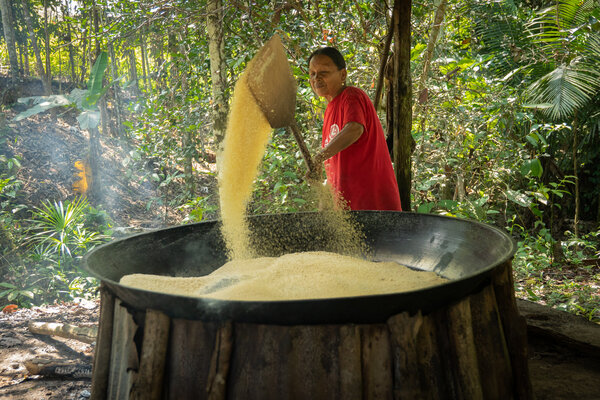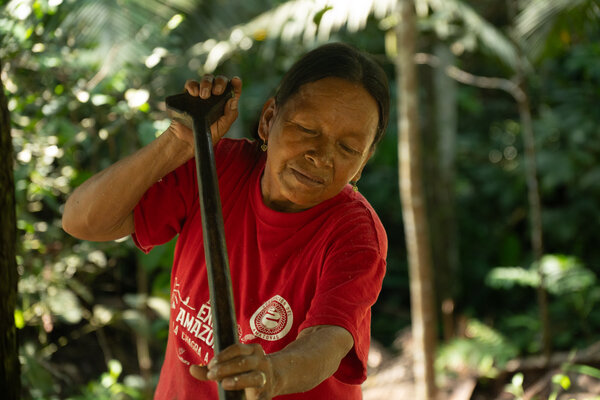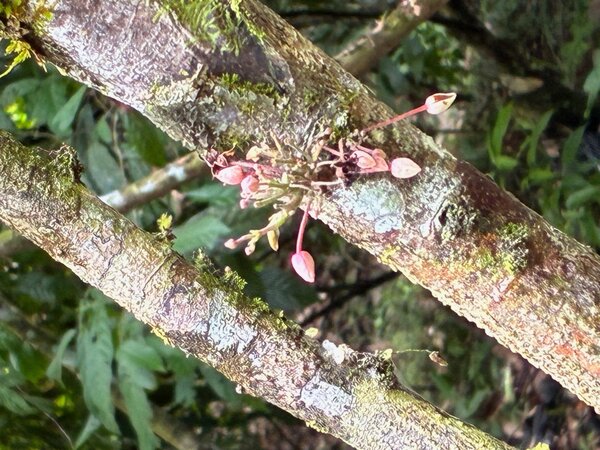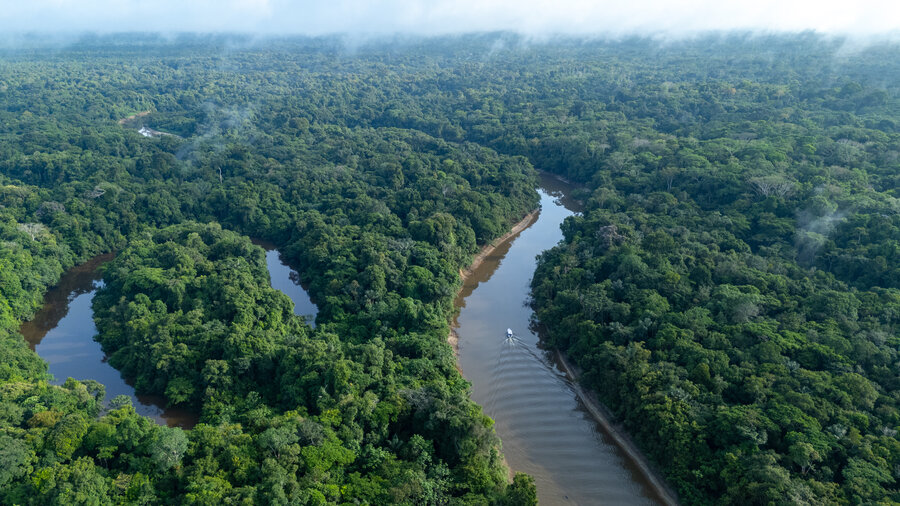Paths to resilience in the Amazon
Seen from the air, the Colombian Amazon is an endless sea of deep emerald. Hidden among the majestic vegetation, are small plots of land, locally known as chagras, where families farm according to ancestral practices that respect the forest and its wildlife.
Crops include yucca, bananas, pineapples, lemons, mangoes and native Amazonian fruits. Some of these, including açaí and castaña, or Brazil nut, are considered superfoods and appreciated worldwide for their nutritional value.
We meet Ligia Valero Ahué in her farm just outside Nueva Esperanza, one of the 26 mostly Indigenous communities the World Food Programme (WFP) is supporting in the Amazonas department of Colombia. As we speak, the lush greenery around us and the air thick with humidity are at odds with her tale of the drought that struck the area in 2024.



“Last year, the drought lasted for the whole month of August. The yucca and bananas we had planted all dried up. Also, we could not produce fariña [a by-product of yucca] because there was no water for processing it,” she says.
The unprecedented drought also affected rivers in the Amazon basin, whose levels dropped by up to 10 meters, leaving communities isolated and fishermen empty-handed. “My son and I went to fish in a spot where fish was always plentiful,” says Doña Ligia. “However, it was all dry and full of flies because the fish had died. It was so sad for the poor fish – the way they died.”
Over the hill, her neighbour Ruperto Ahau Cerrón proudly shows us the cacao trees he singlehandedly tends to since his wife died. Pointing to blossoms sprouting out of the tree trunks, he also laments the effects of changing weather patterns. “When it’s too hot, cocoa trees ‘miscarry’,” he explains, meaning the blossoms dry before they develop into pods.


To protect Amazonian farming and fishing communities from the impact of weather-related disasters, WFP and partners across the region are working on a raft of resilience initiatives, including climate-related insurance that would unlock payouts to local municipalities in case of adverse events.
Money for rainy days
Elsewhere in the Amazon, this is already a reality. Thanks to a collaboration between WFP, the United Nations Environment Programme (UNEP) and the United Nations Office for Disaster Risk Reduction (UNDRR), insurance schemes linked to rainfall indicators have been launched in four districts in Peru, as well as in the Bolivian department of Pando.
Here too, extreme weather is hitting hard. The department’s capital, Cobija, recently saw an abnormal growth of river levels, resulting in extensive flooding. While luckily there were no fatalities, the toll on local communities was heavy, with many losing their homes, crops and livestock.

“As a public authority, you feel powerless when you see the water rising, homes going under and people becoming desperate – and you know you have no resources to help,” says the town’s mayor Ana Lucía Reis.
However, this is set to change. Cobija now benefits from insurance which will release funding when pre-established rainfall thresholds are reached, enabling municipal authorities to quickly address urgent needs.
The relief is evident in mayor Reis’ voice as she talks about this. “Knowing that we can count on insurance in case of future disasters means a lot to me – it eases my mind as we will be able to help families cope,” says Reis.

Amazonian cities like Cobija play an important role in the survival of the forest. They thrive on the commerce of wild Amazonian fruits which, unlike agricultural crops, do not require deforestation, but rather healthy forest ecosystems. Climate action in these cities — including through climate insurance – therefore helps protect livelihoods, reduce vulnerabilities and ensure that the Amazon remains a source of food, well-being and ecological balance for generations to come.
The way urbanization, migration and displacement are rapidly reshaping ancestral knowledge tied to food and land dynamics is very clear to Venezuelan agronomist Genis Olivero. One of the few hundred Warekena Indigenous people still living between Venezuela and northern Brazil, he has witnessed how extreme weather events and social shifts ripple through both the Amazon forest and cities. “Food systems must adapt and change—because climate and societies are changing too,” he says.
“If we don’t act together, everything we know about living in harmony with this region could disappear.”
Many countries, one ecosystem

Spanning several countries, the Amazon constitutes a single ecosystem which is as rich in biodiversity and potential as it is vulnerable to weather-related shocks. Infrastructural constraints, including difficult access to markets, compound these challenges, meaning farmers who could thrive barely survive.
WFP works hand in hand with local communities to find solutions that combine modern technology with ancestral knowledge and practices, making them sustainable and culturally appropriate in a territory that is largely populated by Indigenous Peoples.
“The Amazon is our home. It gives us the air we breathe and the food we eat. It is our pharmacy when we get sick,” says WFP Colombia’s Project Officer Dalvis Ramos, a member of the Indigenous Tikuna-Máguta people, explaining the symbiotic relation of local communities with the environment they live in.
“The work WFP is doing here to strengthen our communities in the face of new challenges also helps us realize the legacy of our ancestors: making sure we protect our Amazon home so that future generations will be able to enjoy it just as we did,” he adds.
FoodPrints (see video) is a WFP project showcasing the transformative power of food through interactive data storytelling. It draws from WFP data across Latin America and the Caribbean, diving deeper into the human narratives hidden within it.
